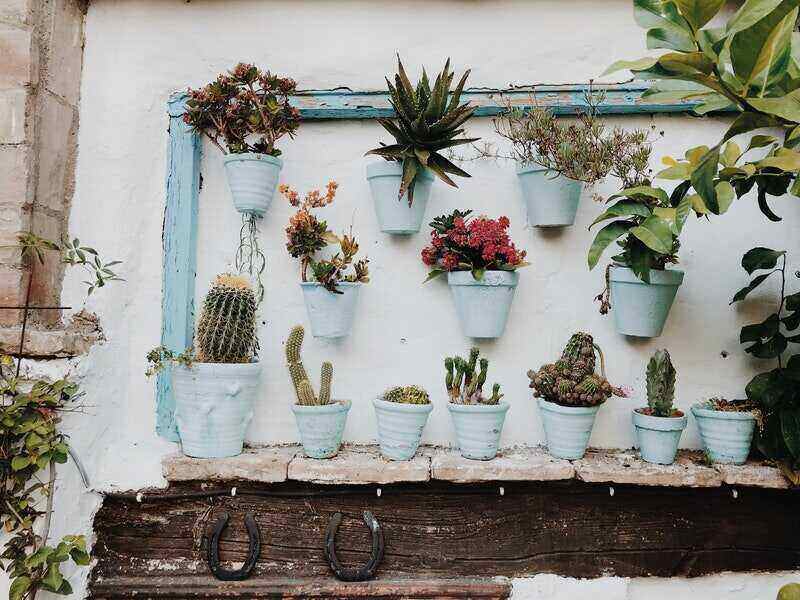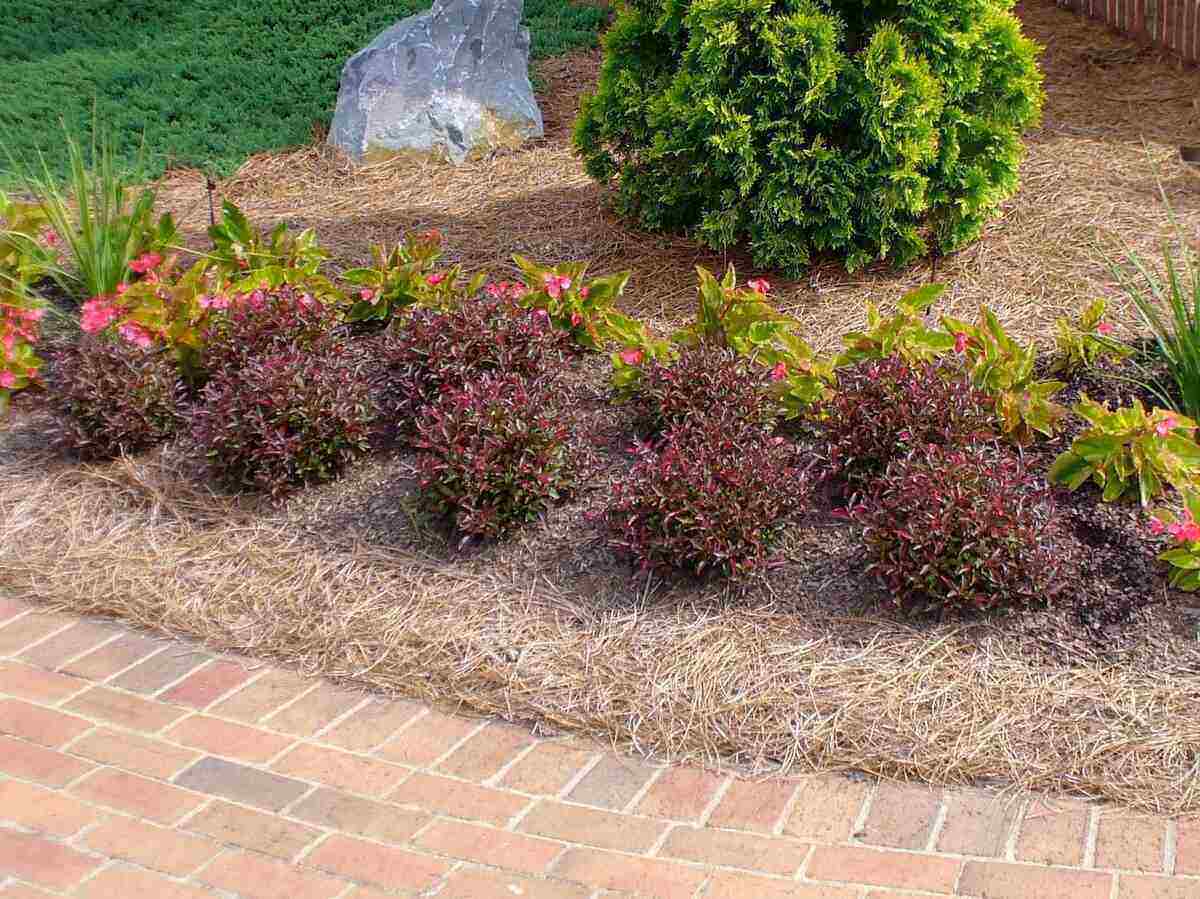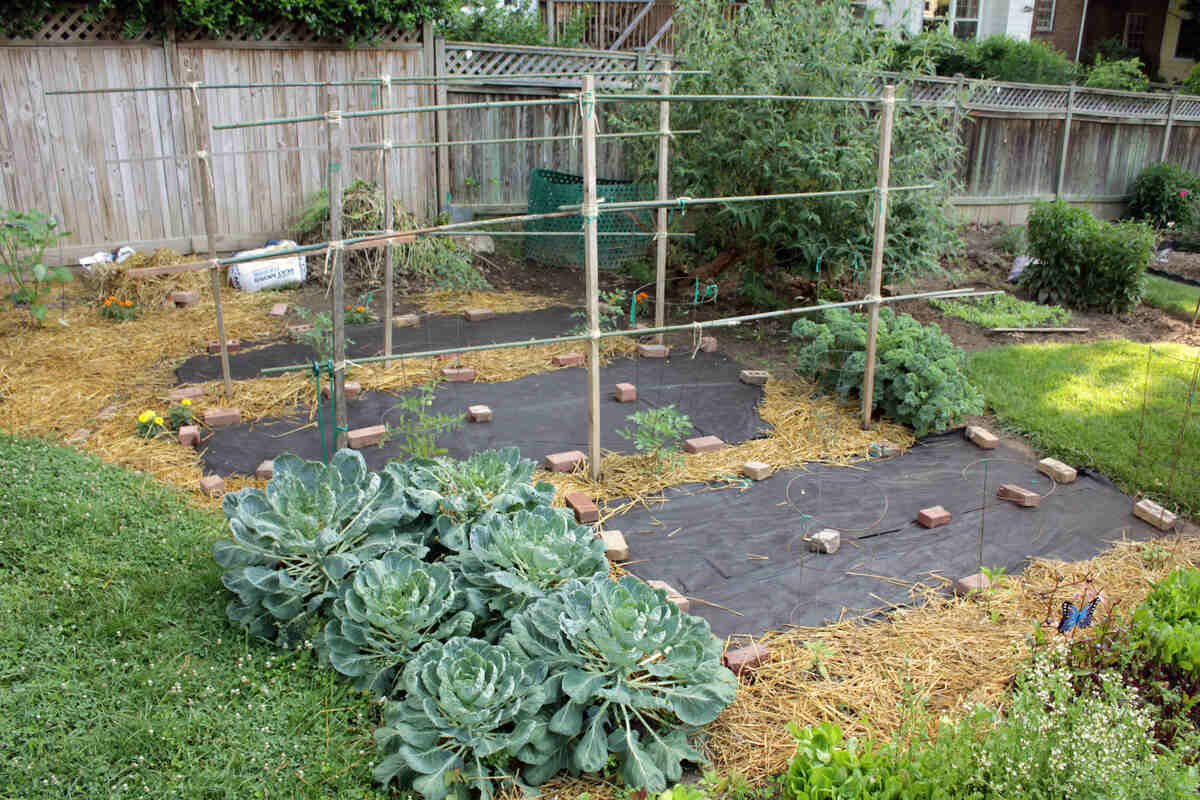
Love it or hate it, landscape fabric is everywhere. Among professional landscapers and amateur gardeners alike, landscape fabric is a popular but controversial weed control method. Most landscape fabric is made from a woven material that smothers weeds while allowing some water to reach plants’ roots. Here’s how to install landscape fabric in nine easy steps.
Shopping for Landscape Fabric
There are many different brands and types of landscape fabric out there. If you want yours to last, choose professional-grade material. The thicker and heavier your weed fabric is, the harder it will be to damage.
Cheap, thin landscaping fabrics tend to tear easily, creating openings for weeds to grow through. You don’t want to go through all the trouble of installing landscape fabric in your flower beds only to have a weed problem again in a few months (or less).
HOOPLE, DeWitt, and FLARMOR make some of the best and toughest weed barriers. Ask your local garden center or home improvement store which landscape fabric in the stock they recommend.
Supplies You’ll Need
Once you’ve chosen your landscape fabric, you’ve got a relatively simple DIY project ahead of you. These are the tools and materials you’ll need to install weed barrier fabric in your garden bed:
- Tape measure
- Garden hoe
- Bow rake
- Utility knife or scissors
- Rubber mallet or hammer
- Landscape staples
- Plants
- Mulch
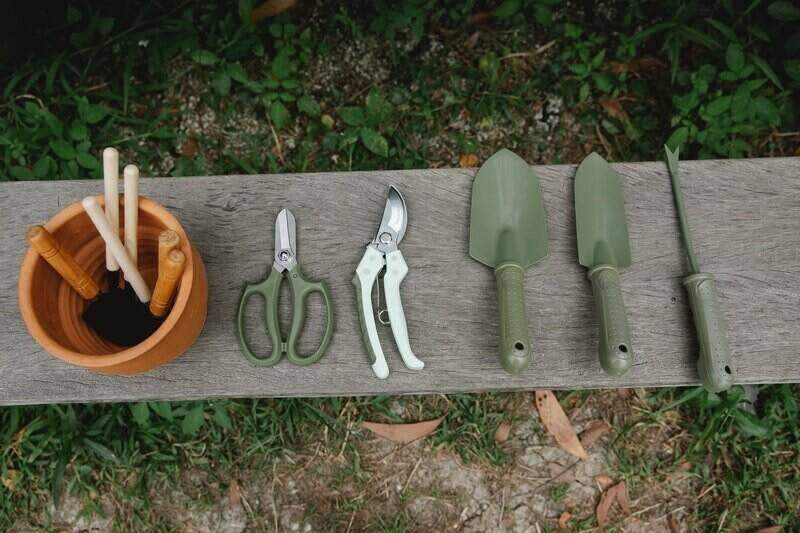
How to Install Landscape Fabric Step-By-Step
Step 1: Measure the Area
First, you’ll need to measure the garden bed where you plan on installing landscape fabric. That way, you’ll know exactly how much material and how many landscape staples to buy.
Step 2: Remove Existing Weeds
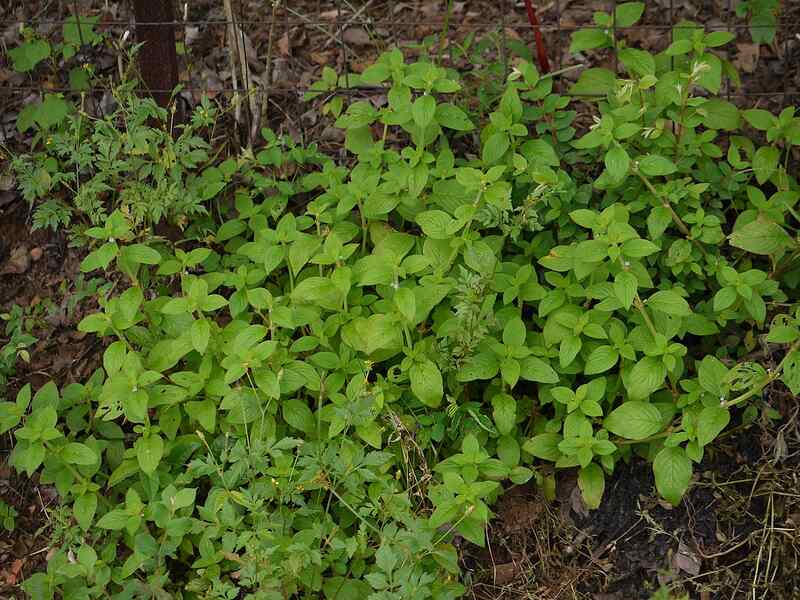
With your garden hoe, dig up any weeds that are already growing in the area where your fabric will go. Make sure to remove all parts of the weeds, including the roots.
Alternatively, you could spray the area with herbicide to ensure you kill all existing weeds. Let them sit for a few days before laying your fabric if you choose to use herbicides.
Step 3: Add Soil Amendments
Once you lay your fabric, you won’t have access to the soil. So if you want to add compost, manure, fertilizer, or any other type of plant food, now is the time.
Step 4: Level the Soil Surface
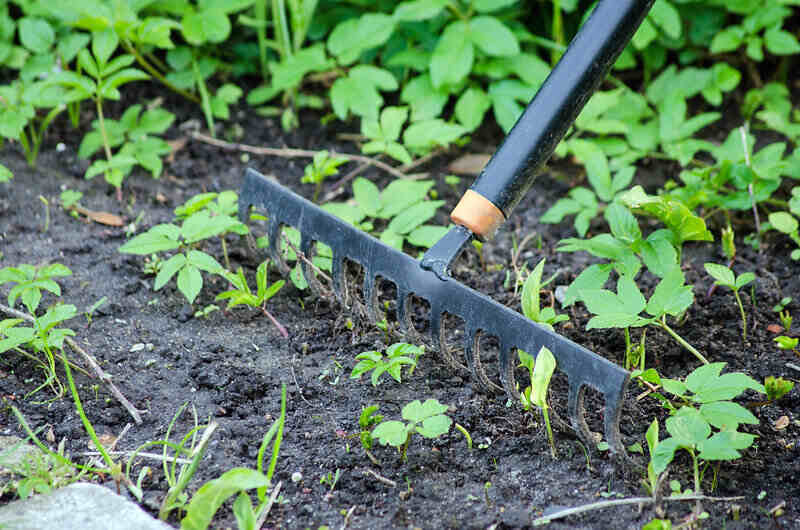
Use your bow rake to remove all uprooted weeds, rocks, twigs, and other debris that could potentially rip the landscape fabric. Rake over the soil to make it as smooth and flat as possible.
Step 5: Lay the Landscape Fabric
Roll out your landscape fabric across the entire area where you want to prevent weed growth. Cut off any excess fabric with your utility knife or scissors, but leave a few extra inches around the edges of your garden bed.
If you need to use more than one sheet of fabric, make sure each section overlaps by 6 to 12 inches. No overlap or insufficient overlap can allow weeds to poke through the seams.
Read the instructions that come with your specific landscape fabric to figure out which side goes face-down in the dirt. Most of the time, you’ll lay it with the fuzzy side down.
Step 6: Secure the Fabric
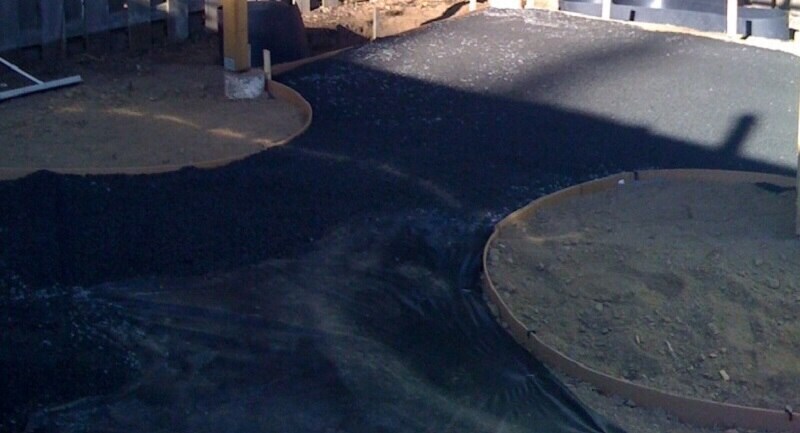
Use landscape staples to hold the fabric down. Tamp the staples securely into the soil with your rubber mallet or hammer.
Don’t skimp on landscape staples if you want your weed barrier to stay in place for years to come. You should use a staple every 8 to 12 inches along all edges of the fabric and any seams where separate sections meet.
Step 7: Plant Your Shrubs or Flowers
Cut an X-shaped incision wherever you want the new plants to go using your utility knife or scissors. Make the incision just big enough for you to dig the hole for the plant’s root ball.
Pull back the triangular flaps of fabric to dig your hole and insert the plant. Then backfill the hole with soil and pack it in around the roots to prevent air pockets.
Once you’re done planting, secure the fabric flaps snugly around the base of the plant. Leave no room for weeds to break through.
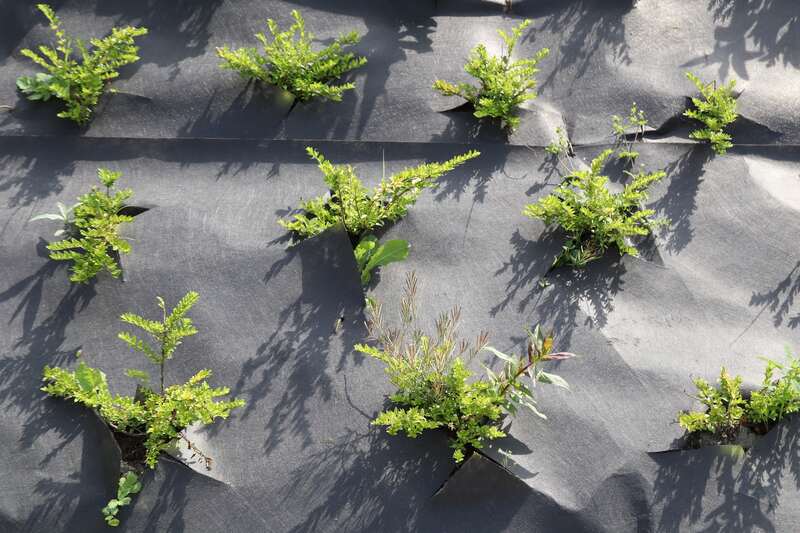
Photo Credit: Pixabay
Step 8: Add Mulch
Add a 2-3 inch layer of mulch on top of the fabric. In addition to making your landscaping look cleaner, the mulch will help anchor the fabric and protect it from harmful ultraviolet (UV) rays. Mulch can also help the soil underneath the fabric retain moisture.
With landscape fabric in place, you can use any type of inorganic or organic mulch you want. Options include wood chips, bark, gravel, river rocks, and rubber.
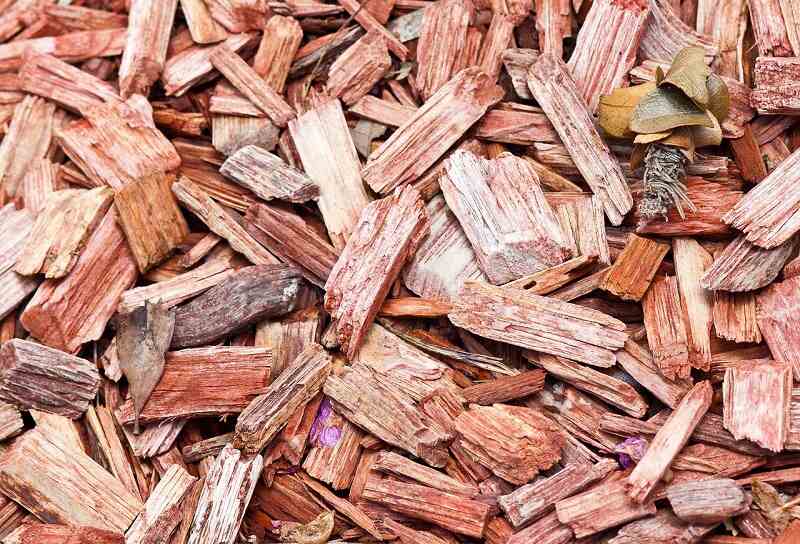
Step 9: Maintain Your Garden Bed
Just because you install landscape fabric doesn’t mean your weeding days are over. Weed seeds can germinate on top of the fabric, using decomposed organic mulch or blown-in dirt as soil.
To prevent new weeds from sprouting, apply a pre-emergent weed control product (such as Preen) to your mulch at the start of every growing season.
If you use organic mulch, it will break down over time and need to be removed and replaced. Leaving the decomposed organic material alone gives weeds a place to grow.
If you use inorganic mulch such as river rocks or rubber, all you’ll have to do for maintenance is remove it and spray it with water if you notice a lot of built-up dirt and debris.
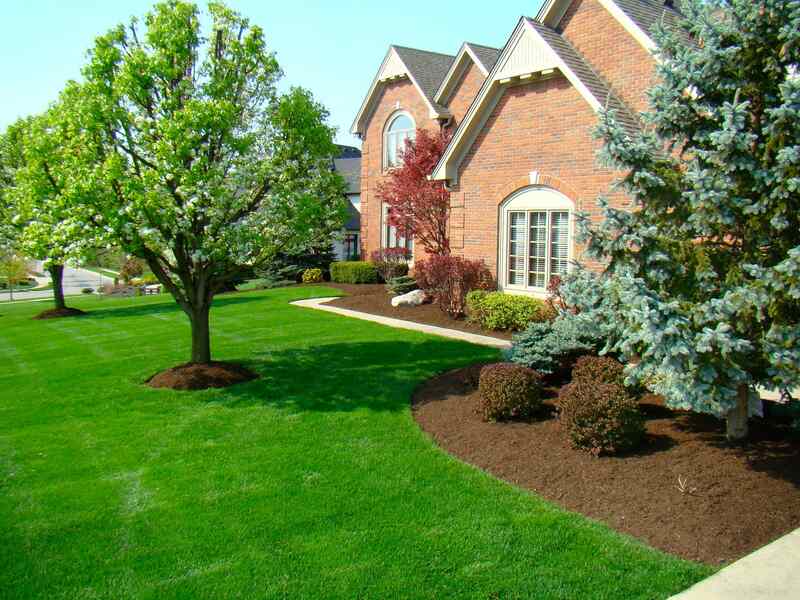
Photo Credit: Tom Britt / Flickr / CC BY 2.0
Installing Landscape Fabric in Special Circumstances
Some conditions will make installing your landscaping fabric a little more complicated, but don’t worry. In most cases, you’ll only have to add a few extra steps to the basic process we already covered.
How to Install Landscape Fabric on a Slope
Before you lay your fabric, you’ll need to carve “shelves” or “steps” into the slope and fill them with large rocks. The rocks will provide a stable base for the landscape fabric to sit on top of.
When you lay the fabric over the stones, make sure separate pieces of fabric overlap in the downhill direction. That way, any mulch that slides downhill won’t be able to slip under the seams and loosen the fabric. This will also keep excess water from getting under the fabric as it drains downhill from the top of the slope.
How to Install Landscape Fabric in a Vegetable Garden
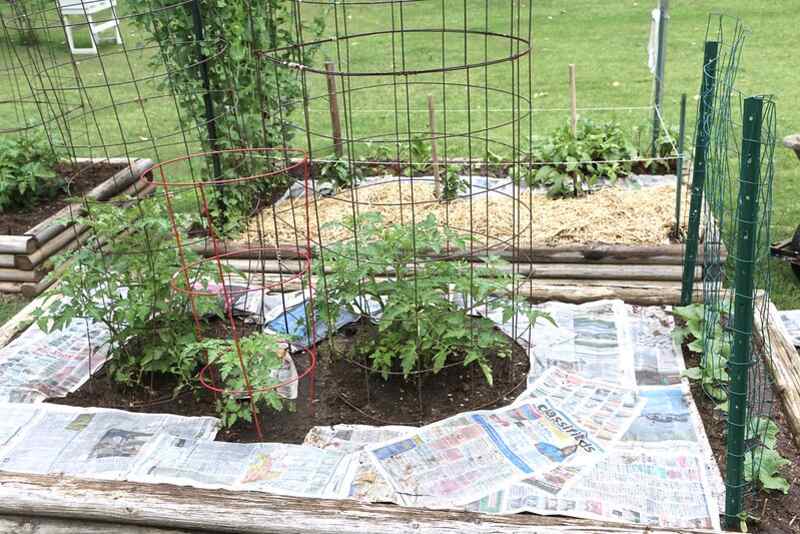
First of all, you should know that landscape fabric is not the best weed barrier for annual vegetable gardens. When you dig up the plants at the end of the growing season, you’re likely to tear the fabric.
Newspaper or cardboard are better choices for vegetable gardens because 1) they’ll eventually break down into the soil and add nutrients and 2) they’re cheap or free, so you won’t have to worry about the cost of replacing them every year.
You can, however, use landscape fabric beneath the soil (instead of on top of it as you would with a regular garden) for raised vegetable gardens. When installing landscape fabric beneath soil, you’ll need to use one unbroken sheet for each bed. Then, anchor the sheet with landscape staples and shovel the soil for your vegetables over it.
How to Install Landscape Fabric With Edging
It’s easy to install landscape fabric and a new landscaping edge simultaneously. When you lay the fabric, leave several extra inches at the edge of the garden bed.
When you install your landscape edging, you’ll need to dig a trench for it. Wrap the extra landscape fabric around the bottom of the edging material before sinking it into the trench. The edging will secure the landscape fabric.
If you’re laying landscape fabric in a bed that already has edging, simply tuck the excess fabric securely between the soil and the edging material.
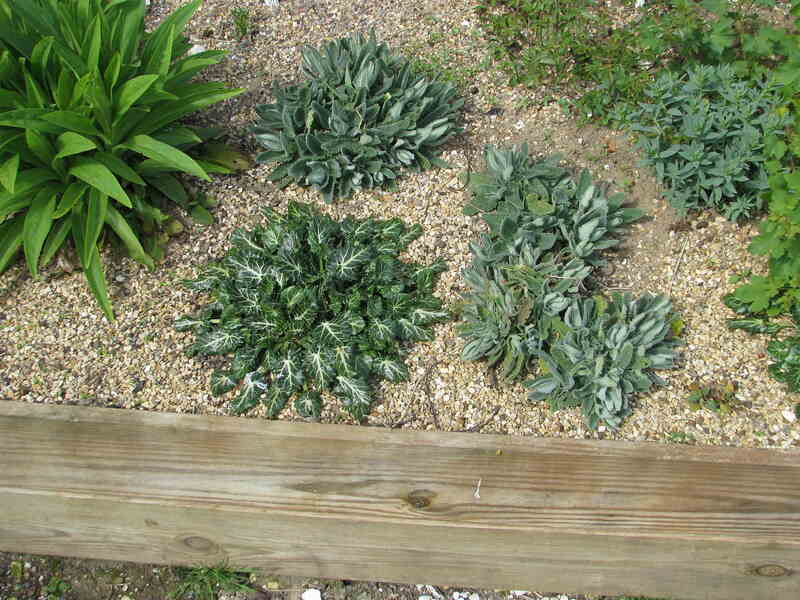
Photo Credit: peganum / Flickr / CC BY-SA 2.0
How to Install Landscape Fabric Around Trees
For a fully grown large tree, you’ll have to overlap several pieces of fabric around the base of the tree’s trunk. As you would with a regular garden bed, secure the individual sheets with landscape staples.
For a tree seedling, use a 4-foot-by-4-foot or 6-foot-by-6-foot square of landscape fabric. Cut a hole in the center of the square where the seedling will go.
After you lay the piece of fabric around the seedling, dig a 3- to 6-inch deep trench around the edges. Tuck the landscape fabric into the trench and cover it with soil to hold it down (or use edging or landscape staples to anchor the fabric).
FAQ About Installing Landscape Fabric
That’s up to you. Many DIY-ers find it easier to plant through an incision in the fabric after laying it than to figure out where and how large to cut holes for existing plants.
Yes, cardboard and newspaper are popular biodegradable weed barriers that many gardeners use in place of landscape fabric.
Yes, you can purchase non-woven geotextile fabric, a type of landscaping fabric, for your French drain.
You Don’t Have To Install Landscaping Fabric By Yourself
Although installing landscaping fabric is a pretty straightforward process, you may not want to go at it alone. Keep in mind that you are only a phone call or click away from a professional landscaper who can help you with this and many of your other landscaping needs.
Aside from laying weed fabric, a landscaping pro can design and install your whole planting bed. Under their expert care, your landscape can reach its full potential.
It’s up to you whether or not landscape fabric is the right choice for your garden. But if you decide to install it, now you’ll know exactly what you’re doing.
Main Photo Credit: woodleywonderworks / Flickr / CC BY 2.0
![Landscape Fabric Types and How to Use Them [Guide] there plants with landscape fabric beneath](https://www.lawnstarter.com/blog/wp-content/uploads/2020/10/5778384155_5c5f13a470_k-1-e1616263637434.jpg)
